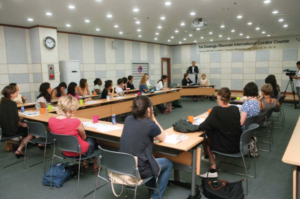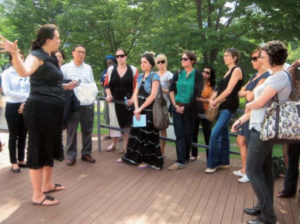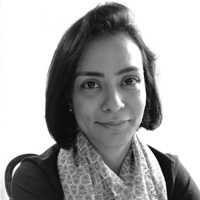The first Gwangju Biennale International Curator Course, sponsored by the Gwangju Biennale Foundation and the Gwangju Metropolitan City, was held from August 24th to September 20th. The participants selected, were 26 young curators from 15 different countries.
The course was chaired by Mr. Yongwoo Lee (Executive Vice President of the Gwangju Biennale Foundation); and directed by Byungsoo Eun (Artistic Director of Gwangju Design Biennale, 2009) and Massimiliano Gioni (Artistic Director of Gwangju Biennale, 2010).

Barbara Vanderlinden (internationally renowned curator, writer and founding artistic director of the Brussels Biennale) was the Visiting Professor, with whom the participants had the maximum interaction.
The role of a curator has in recent times become extremely crucial in the art world. Established art critics and writers, began to curate shows based on their extensive knowledge in this field. Ranjit Hoskote, a poet, critic and now an independent curator was invited as a curator to the 2008 Gwangju Biennale.
Art institutes, such as the Royal College of Art, the Courtauld Institute and Goldsmith’s College in U.K., have expanded their programmes beyond art history and theory into the field of curation. India’s structure for art courses is beginning to take off with a number of institutes and auction houses diversifying into the education sector.
However, the Gwangju Biennale International Curator Course is the first of its type, which gave us students a first-hand experience of curating a biennale, where several curators worked under a theme set by the artistic director. Being the only Indian in the course and the only non-Korean in the Sound section of the biennale, I did encounter a slight language problem – but on breaking barriers through sign language and sometimes misinformed interpretations, the course was a very good learning experience and exchange of thoughts and ideas from around the world.
Being the first course of its type, there were organising glitches – such as coordination with visiting lecturers and the interests of the participants, who were interested more in art than design. Since this course coincided with the Design Biennale, several lecturers were misinformed about our focus – and emphasised more on design than art.

However, there were distinguished curators, such as Maurizio Bortolotti, Sungjung Kim and Lu Jie, among others who shared their curatorial projects and experiences. Massimiliano Gioni was assigned only one lecture with us towards the end of the course, and a special group meeting was fortunately organised on his request for further discussion and exchange of ideas with the participants on our views on the local art scene in Gwangju and its relation with the rest of South Korea and the world.
The government plays a crucial role in the development of art and art spaces. The Gwangju Biennale is the only Biennale in the world, which has a building dedicated for this bi-annual event. The emphasis of the existence through a space, places Gwangju within an international context.
At several points during the course, such as a visit to the Asian Cultural Hub Centre, University libraries and research papers the emphasis was laid more on local context rather than on the global. Being an international course, one would have expected to delve into worldwide practices on art.
However, despite certain drawbacks, the Gwangju Biennale Curator Course has created a platform between curators and critics at an international level for development of future projects and exchange of ideas and curatorial practices.














